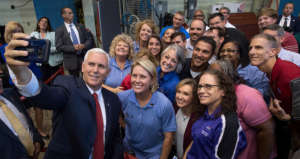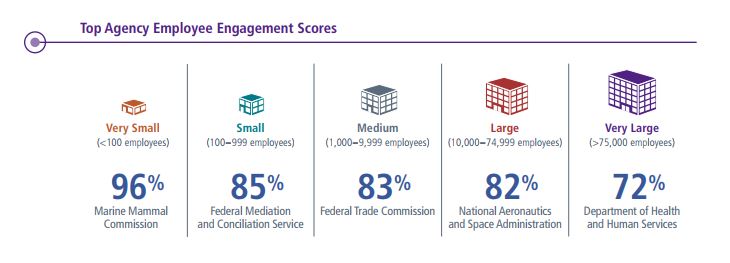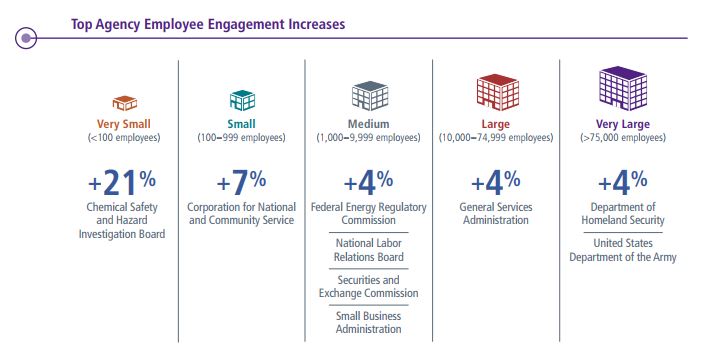
Federal employee engagement highest in 6 years, OPM survey says
The latest Federal Employee Viewpoint Survey results show higher overall employee engagement across the government in 2017.
Federal employee engagement rose to a six-year high in 2017, according to the latest results of the Federal Employee Viewpoint Survey.
Overall employee engagement topped 67 percent in 2017, a 2 percent bump over last year’s score of 65. The Obama administration had wanted to reach an engagement goal of 67 percent by 2016, yet agencies finally reached that mark one year later.
The survey results, which the Office of Personnel Management released Thursday afternoon, are designed to take the pulse of how federal employees are feeling about their jobs, workplaces and their agency’s leadership.
“While the 2017 results are very positive, survey responses also show several key aspects of federal workplaces could be improved,” OPM acting Director Kathleen McGettigan said. “Based on employee perspectives, agencies would be more effective to the extent that leaders are able to address insufficient resources, recruit for the right skills, recognize employees’ performance and generate commitment and motivation in the workforce.”
It’s the third consecutive year of overall improvements in several categories.
Leadership has struggled in recent years to earn positive scores, but federal employees appeared to hold a more positive view of their top leaders in 2017. About 55 percent of federal employees held a positive perception of their agency’s leadership, compared with 53 percent in 2016.
Roughly 74 percent of federal employees rated their supervisors highly — another 2 percent bump over the previous year.
The “new inclusion quotient,” which measures whether federal employees believe their workplaces are fair, open, cooperative, supportive and empowering also rose 2 percent in 2017 from 58 percent in 2016 to 60 percent this year.
OPM administered the 2017 survey in two, 6-week waves starting in May.
The 2017 survey included 84 questions. Scores increased or remained the same on all but one question, which measured whether federal employees felt their offices could recruit new talent with the right skills. Just 42 percent of respondents believed their agencies could attract the new hires they need.
Like in recent years, some familiar trends continued.
Just 31 percent of respondents said steps are taken at their agencies to deal with a poor performer who won’t improve, a 2 percent bump over last year’s score of 29 percent.

A quarter of federal employees believed pay raises depended on how well employees performed at their jobs, and just 41 percent of respondents said their organizations rewarded creativity and innovation.
Many familiar faces kept their top spots on the 2017 FEVS.
Both NASA and the Federal Trade Commission, which earned the highest ranks for their size last year, improved their scores and kept their top spots.
NASA improved from a score of 80 percent to 82 percent over the past year, while FTC saw a 1 percent bump from last year’s score of 82 percent.
The Federal Mediation and Conciliation Service, which ranks at the top among small agencies, boosted its scores from 82 percent to 85 percent over the past year.
Meanwhile, the Marine Mammal Commission again sits at the top among agencies with fewer than 100 employees. It also increased its engagement score by 4 percent.

The Homeland Security Department, which reversed a six-year trend of declining engagement scores for the first time last year, improved by 4 percent in 2017.
DHS and the Department of the Army tied for the most improved very large agency this year.
DHS’ 4 percent improvement is impressive, considering the agency’s long history at the bottom of the FEVS ranks and the department’s changes in top leadership over the past year.
Former DHS Secretary Jeh Johnson said he hoped 2016 was the start of a new upward trend, and White House Chief of Staff John Kelly said during his brief tenure as secretary earlier this year that low employee morale would change for the better.

The General Services Administration, Federal Energy Regulatory Commission, National Labor Relations Board, Securities and Exchange Commission and Small Business Administration also improved by 4 percent this year.
The Chemical Safety and Hazard Investigation Board improved by 21 percent this year, the largest increase of any agency.
Copyright © 2025 Federal News Network. All rights reserved. This website is not intended for users located within the European Economic Area.
Nicole Ogrysko is a reporter for Federal News Network focusing on the federal workforce and federal pay and benefits.
Follow @nogryskoWFED





